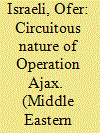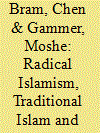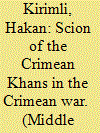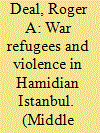|
|
|
Sort Order |
|
|
|
Items / Page
|
|
|
|
|
|
|
| Srl | Item |
| 1 |
ID:
121468


|
|
|
|
|
| Publication |
2013.
|
| Summary/Abstract |
From Abdül-Hamid's regime and onward, cartoons have been a powerful influential gauge and have played an important role in the political arena in Turkey. The purpose of this essay is to express continuity in the way Turkish politicians have reacted to cartoons throughout the years. This essay argues that cartoons create a change in public opinion and are thus perceived as a threat to the regime, which therefore wishes to eliminate or minimize the cartoon's power. This essay will discuss the similarities and distinctions of regime responses in Turkey, introduce the history and the conception of cartoons in Ottoman Empire-Turkey and will dedicate a prominent part to the Erdogan's attitude to cartoons and its impact on Turkish society.
|
|
|
|
|
|
|
|
|
|
|
|
|
|
|
|
| 2 |
ID:
121470


|
|
|
|
|
| Publication |
2013.
|
| Summary/Abstract |
In seeking to protect its economic interests and its control of oil resources in Iran, Britain planned to overthrow Iranian Prime Minister Dr Mohammad Mossadegh in a military coup d'état following his decision to nationalize the Iranian oil industry in 1951. However, the British initially faced strong opposition to this plan from the US under the Truman administration, which preferred a more diplomatic approach to the crisis and did not see British interests as being in line with its own. Facing this opposition and after unsuccessful attempts to oust the Iranian leader through economic pressure and propaganda campaigns, the British skillfully leveraged American fear of Communism to secure Washington, under the Eisenhower Administration, as a partner to lead a joint US-UK mission to overthrow Mossadegh. This paper explores the reasons behind the shift in American policy regarding this issue, exploring whether it was the Brit's successful use of covert, circuitous tactics to achieve their intended outcomes or solely a result of ideological differences between the two US administrations.
|
|
|
|
|
|
|
|
|
|
|
|
|
|
|
|
| 3 |
ID:
121465


|
|
|
|
|
| Publication |
2013.
|
| Summary/Abstract |
The Silk Letters Conspiracy, or Case, was a plot by a small clique of Indian Pan-Islamists located in Afghanistan, India and the Hijaz to overthrow British rule in India during the First World War. Although British officials at the time were prepared to admit that the conspiracy had been 'organised with some skill', there was a general feeling that it was a rather 'pathetic' and 'ineffectual' affair, and 'crazy in the extreme'. This verdict has been echoed by those who have subsequently considered the plot, if only in passing. But there is more to the Silk Letters Conspiracy than meets the eye, as this article will detail. In retrospect, the Case has a greater significance than previously thought in terms of Britain's encounter with Pan-Islam.
|
|
|
|
|
|
|
|
|
|
|
|
|
|
|
|
| 4 |
ID:
121472


|
|
|
|
|
| Publication |
2013.
|
| Summary/Abstract |
This article will discuss the school textbooks in history and civic in the elementary and secondary schools of Jordan between 1964 and 1994 and will show that the changes in the narrative manifested in the school textbooks in the course of these years were influenced by the political, ideological and national needs of Jordanian regime in this period and especially in the light of the Palestinian component in the Jordanian society that presented not only a national-ideological, but also a physical and existential challenge to the integrity of the kingdom. The article will show how, in view of the developments in the Palestinian arena, the school textbooks reflect an attempt on part of the Jordanian regime to forge a national Arab and Jordanian-Palestinian identity up to the end of the 1960s whereas since the beginning of the 1970s, the emphasis is placed on a separate Jordanian territorial identity.
|
|
|
|
|
|
|
|
|
|
|
|
|
|
|
|
| 5 |
ID:
121471


|
|
|
|
|
| Publication |
2013.
|
| Summary/Abstract |
The article addresses the issues involved in Turkey's watchful neutrality vis-á-vis the Kurdish mobilization and the temporary autonomy deal in Iraq during the 1970s. Regardless of Ankara's long-held concerns about the spillover effects of the cross-border ethnic issues and growing outside assistance to the Kurdish insurgency by the US, Iran and Israel against Baghdad, Turkey stood aloof to the internationalisation of the Kurdish developments in Iraq. The successive governments in Turkey generally saw the Kurdish-Baghdad confrontation throughout the 1960s and early 1970s in the context of the Cold war and therefore were able to overlook its possible implications on its own Kurds, especially in view of the assurances extended to itself by its allies involved. Having no acute perception of vulnerability due to international conjuncture, the relations with the allies and domestic politics, Turkey seemed not to have any particular instrumental, affective or humanitarian motives to actively get involved in the then significant Kurdish developments in Iraq.
|
|
|
|
|
|
|
|
|
|
|
|
|
|
|
|
| 6 |
ID:
121473


|
|
|
|
|
| Publication |
2013.
|
| Summary/Abstract |
This study examines the interplay between Islam and collective identity and their position in potential conflicts by exploring the dynamics of Islam, ethno-nationalism and civic society within different parts of the Northern Caucasus. Historical and anthropological approaches are used for a comparative analysis of Daghestan and Chechnya in the east and of Kabardino-Balkaria and Karachai-Cherkesia in the west. The study demonstrates the importance of local context and historical background to the understanding of ethnicity, nationalism, civic identity and their interplay with Islam. The analysis highlights that the different history and socio-cultural characteristics of the different regions in question leads to different approaches to religion which contain a paradox. In Daghestan and Chechnya, Islam is well established and the authorities have to collaborate with different Islamic bodies in their struggle against 'Wahhabism'. In Kabardino-Balkaria and Karachai-Cherkesia the 'legitimate' Islamic leaders - whether those representing the state or leaders of other Islamic movements - are powerless. While this represents the overall weak position of Islam in these areas, paradoxically it also opens options for radical Islamists to gain support, in the context of economic hardships, weakening of other sources of identification, and corruption. This process is generated and fostered by policies that limit ethno-nationalism and expand the struggle against radicalism to a struggle against religious activity in general. The Northern Caucasus has often been perceived as a major locus of radical Islam, and as a strategic rift in the 'clash of civilizations'. This study claims that the significant rifts and conflicts are between different Islamic alternatives. Important variables crucial to this discussion highlighted by the case of the Northern Caucasus are ethnicity, nationalism, civic identity and their interplay with Islam. At the same time, this case also highlights that the potential of radicalism in Islamic societies is not the mere result of its own 'characteristics', but is also a product of policy towards Islamic societies by outside actors, in this case Russia.
|
|
|
|
|
|
|
|
|
|
|
|
|
|
|
|
| 7 |
ID:
121467


|
|
|
| 8 |
ID:
121464


|
|
|
|
|
| Publication |
2013.
|
| Summary/Abstract |
This article studies the origins and functions of a belief in Jewish race in the Arab fin de siècle through a case study of the writings of Shahin Makaryus and al-Muqtaaf, the influential journal he co-edited. The article begins by examining the racial definition of the Jews proffered by Makaryus and al-Muqtaaf. It situates this view, first, within the then-recent controversy surrounding Darwinism and the problem of secularism within the Arab renaissance of the fin de siècle and, second, within the contemporary Egyptian discourse about race concerning Egypt's rule over the Sudan. It then studies the presumed implications of this categorization of the Jews for their supposed racial relatives, the Arabs. It argues that it was precisely the imagined racial link between Jews and Arabs that made race an attractive category for understanding the Jews in the minds of certain Nahda thinkers. Next, it examines Makaryus's approach to Jewish nationalism and Zionism and contends that his apparent sympathy toward the movement may be understood, at least in part, in relation to his racial definition of the Jews. Finally, it concludes with some reflections on the implications of this study for our understanding of secularism in the world of the Nahda.
|
|
|
|
|
|
|
|
|
|
|
|
|
|
|
|
| 9 |
ID:
121469


|
|
|
|
|
| Publication |
2013.
|
| Summary/Abstract |
The idea of constructing the Transiranian Railway appeared for the first time in the end of the nineteenth century. Until the 1920s it was widely discussed by diplomats from different powerful countries (like Great Britain and Russia) who perceived it as an occasion to enlarge their countries' sphere of influence. However, it was the Iranian government itself, led by the Iranian Shah, that managed to complete the project. The Transiranian Railway connected the Caspian Sea shore with the Persian Gulf and is considered one of the greatest engineering achievements of the 1930s. This paper presents the main aspects of the history of the Transiranian Railway - from the nineteenth century's debates around the concept of such a connection, through the process of the line's construction during Reza Shah's reign, until the post-war period of railway development in Iran. To the historical part comments are added on some aspects of the social, economic and political consequences of the construction of the railway.
|
|
|
|
|
|
|
|
|
|
|
|
|
|
|
|
| 10 |
ID:
121466


|
|
|
|
|
| Publication |
2013.
|
| Summary/Abstract |
This paper examines the place of war refugees in patterns of interpersonal violence in Istanbul in the 1890s. I argue that refugees, especially from the 1878 Russo-Turkish war, committed a disproportionate amount of criminal violence, and that their violent acts were often more extreme than those of other groups. I argue that factors such as poverty are insufficient to explain the degree of difference from the patterns of the general population. It is also necessary to look at an important cultural factor that most of these refugees share: exposure to and experience of violence. The conflicts from which the subjects of my paper were fleeing were particularly brutal ones, and thus could be expected to have a particularly brutalizing effect.
|
|
|
|
|
|
|
|
|
|
|
|
|
|
|
|
|
|
|
|
|